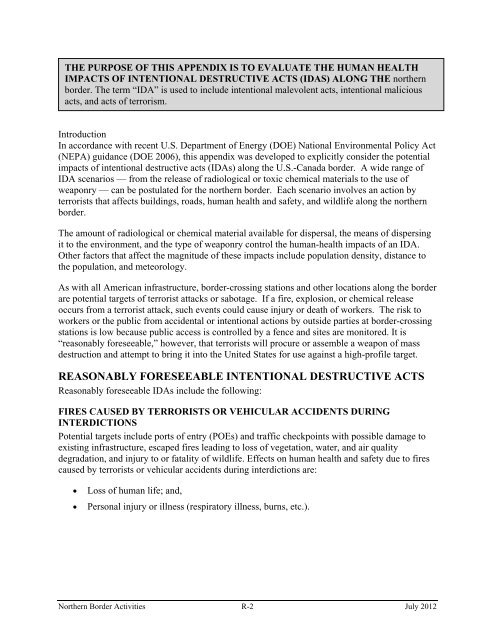Appendix R - Intentional Destructive Acts - CBP.gov
Appendix R - Intentional Destructive Acts - CBP.gov
Appendix R - Intentional Destructive Acts - CBP.gov
Create successful ePaper yourself
Turn your PDF publications into a flip-book with our unique Google optimized e-Paper software.
THE PURPOSE OF THIS APPENDIX IS TO EVALUATE THE HUMAN HEALTH<br />
IMPACTS OF INTENTIONAL DESTRUCTIVE ACTS (IDAS) ALONG THE northern<br />
border. The term “IDA” is used to include intentional malevolent acts, intentional malicious<br />
acts, and acts of terrorism.<br />
Introduction<br />
In accordance with recent U.S. Department of Energy (DOE) National Environmental Policy Act<br />
(NEPA) guidance (DOE 2006), this appendix was developed to explicitly consider the potential<br />
impacts of intentional destructive acts (IDAs) along the U.S.-Canada border. A wide range of<br />
IDA scenarios — from the release of radiological or toxic chemical materials to the use of<br />
weaponry — can be postulated for the northern border. Each scenario involves an action by<br />
terrorists that affects buildings, roads, human health and safety, and wildlife along the northern<br />
border.<br />
The amount of radiological or chemical material available for dispersal, the means of dispersing<br />
it to the environment, and the type of weaponry control the human-health impacts of an IDA.<br />
Other factors that affect the magnitude of these impacts include population density, distance to<br />
the population, and meteorology.<br />
As with all American infrastructure, border-crossing stations and other locations along the border<br />
are potential targets of terrorist attacks or sabotage. If a fire, explosion, or chemical release<br />
occurs from a terrorist attack, such events could cause injury or death of workers. The risk to<br />
workers or the public from accidental or intentional actions by outside parties at border-crossing<br />
stations is low because public access is controlled by a fence and sites are monitored. It is<br />
“reasonably foreseeable,” however, that terrorists will procure or assemble a weapon of mass<br />
destruction and attempt to bring it into the United States for use against a high-profile target.<br />
REASONABLY FORESEEABLE INTENTIONAL DESTRUCTIVE ACTS<br />
Reasonably foreseeable IDAs include the following:<br />
FIRES CAUSED BY TERRORISTS OR VEHICULAR ACCIDENTS DURING<br />
INTERDICTIONS<br />
Potential targets include ports of entry (POEs) and traffic checkpoints with possible damage to<br />
existing infrastructure, escaped fires leading to loss of vegetation, water, and air quality<br />
degradation, and injury to or fatality of wildlife. Effects on human health and safety due to fires<br />
caused by terrorists or vehicular accidents during interdictions are:<br />
<br />
<br />
Loss of human life; and,<br />
Personal injury or illness (respiratory illness, burns, etc.).<br />
Northern Border Activities R-2 July 2012
















